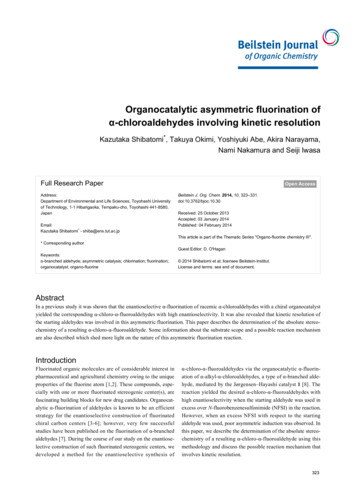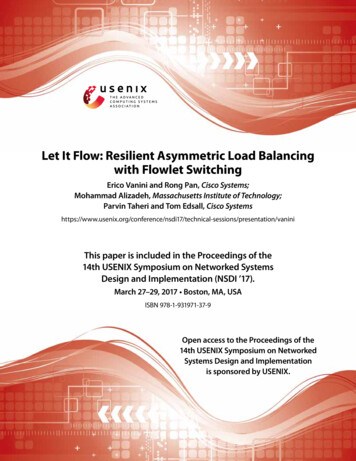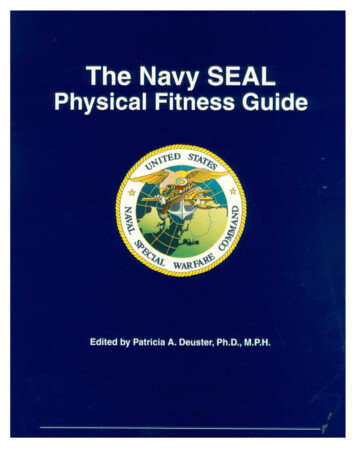
Transcription
Organocatalytic asymmetric fluorination ofα-chloroaldehydes involving kinetic resolutionKazutaka Shibatomi*, Takuya Okimi, Yoshiyuki Abe, Akira Narayama,Nami Nakamura and Seiji IwasaFull Research PaperAddress:Department of Environmental and Life Sciences, Toyohashi Universityof Technology, 1-1 Hibarigaoka, Tempaku-cho, Toyohashi 441-8580,JapanEmail:Kazutaka Shibatomi* - shiba@ens.tut.ac.jpOpen AccessBeilstein J. Org. Chem. 2014, 10, 323–331.doi:10.3762/bjoc.10.30Received: 25 October 2013Accepted: 03 January 2014Published: 04 February 2014This article is part of the Thematic Series "Organo-fluorine chemistry III".* Corresponding authorGuest Editor: D. O'HaganKeywords:α-branched aldehyde; asymmetric catalysis; chlorination; fluorination;organocatalyst; organo-fluorine 2014 Shibatomi et al; licensee Beilstein-Institut.License and terms: see end of document.AbstractIn a previous study it was shown that the enantioselective α-fluorination of racemic α-chloroaldehydes with a chiral organocatalystyielded the corresponding α-chloro-α-fluoroaldehydes with high enantioselectivity. It was also revealed that kinetic resolution ofthe starting aldehydes was involved in this asymmetric fluorination. This paper describes the determination of the absolute stereochemistry of a resulting α-chloro-α-fluoroaldehyde. Some information about the substrate scope and a possible reaction mechanismare also described which shed more light on the nature of this asymmetric fluorination reaction.IntroductionFluorinated organic molecules are of considerable interest inpharmaceutical and agricultural chemistry owing to the uniqueproperties of the fluorine atom [1,2]. These compounds, especially with one or more fluorinated stereogenic center(s), arefascinating building blocks for new drug candidates. Organocatalytic α-fluorination of aldehydes is known to be an efficientstrategy for the enantioselective construction of fluorinatedchiral carbon centers [3-6]; however, very few successfulstudies have been published on the fluorination of α-branchedaldehydes [7]. During the course of our study on the enantioselective construction of such fluorinated stereogenic centers, wedeveloped a method for the enantioselective synthesis ofα-chloro-α-fluoroaldehydes via the organocatalytic α-fluorination of α-alkyl-α-chloroaldehydes, a type of α-branched aldehyde, mediated by the Jørgensen–Hayashi catalyst 1 [8]. Thereaction yielded the desired α-chloro-α-fluoroaldehydes withhigh enantioselectivity when the starting aldehyde was used inexcess over N-fluorobenzenesulfonimide (NFSI) in the reaction.However, when an excess NFSI with respect to the startingaldehyde was used, poor asymmetric induction was observed. Inthis paper, we describe the determination of the absolute stereochemistry of a resulting α-chloro-α-fluoroaldehyde using thismethodology and discuss the possible reaction mechanism thatinvolves kinetic resolution.323
Beilstein J. Org. Chem. 2014, 10, 323–331.Results and DiscussionIn our previous study [8], enantioselective fluorination ofracemic 2-chloro-3-phenylpropanal (2a) was carried out with3 equiv of NFSI in the presence of organocatalyst (S)-1 to yieldthe corresponding α-chloro-α-fluoroaldehyde 3a in goodconversion. Isolation of the product and determination of enantiomeric purity were performed after reduction to primaryalcohol 4a because 3a was unstable to silica gel chromatography. The reaction afforded 4a with high enantioselectivityalong with the monochloro alcohol 5a, whose enantiomericpurity was determined to be 37% ee (Scheme 1) [8]. Theseresults suggested that kinetic resolution of the starting aldehydes was involved in this asymmetric fluorination.To collect further information on the reaction mechanism, wesought to determine the absolute configuration of 4a. Recently,we reported the enantioselective synthesis of α-chloro-α-fluoroβ-keto esters via the sequential chlorination–fluorination ofβ-keto esters with the Cu(II) complex of SPYMOX [9], a spirochiral oxazoline ligand developed by our research group [9-12].In that study, we succeeded in determining the absolute stereochemistry of the α-chloro-α-fluoro-β-keto ester 6 by the X-raycrystallographic analysis of its derivative 7 (Scheme 2). Here,our aim was to transform chlorofluoro ester 6 to 4a in order tocompare its optical rotation with that of 4a derived from 2a inthe presence of catalyst (S)-1. As shown in Scheme 3, β-ketoester 6 was converted via the Barton–McCombie deoxygenation [13] into a simple ester 10, which was then reduced to theprimary alcohol 4a by treatment with LiAlH4. Comparison ofthe optical rotations and retention times on chiral HPLC clearlyshowed that the asymmetric fluorination of 2a catalyzed by(S)-1 yielded 4a having the R configuration (Scheme 1).An investigation of the substrate scope of the organocatalyticfluorination of α-chloroaldehydes was performed as shown inTable 1. The reaction of 2a with 3 equiv of NFSI yielded 4a in87% ee along with monochloro alcohol 5a in 37% ee (Table 1,entry 2) as described above. On the other hand, the reactionwith 2 equiv of NFSI against to 2a showed poor enantioselectivity (31% ee, Table 1, entry 1). We also examined thereaction with 2 equiv of 2a based on NFSI. The reaction yielded4a in 75% ee (lower ee than that in Table 1, entry 2), and theenantiomeric purity of the recovered 5a was increased to52% ee (Table 1, entry 3). Similar trends were observed in thefluorination with some other substrates 2b–2g (Table 1, entries4–14). These results strongly suggested that the high asym-Scheme 1: Organocatalytic enantioselective fluorination of α-chloroaldehyde 2a [8].Scheme 2: Determination of absolute configuration of α-chloro-α-fluoro-β-keto ester 6 by X-ray analysis [9].324
Beilstein J. Org. Chem. 2014, 10, 323–331.Scheme 3: Transformation of α-chloro-α-fluoro-β-keto ester 6 to chlorofluoro alcohol 4a.Table 1: Enantioselective fluorination of α-chloroaldehydes.aentryR2:NFSIt (h)% yield of 4b% ee of 4c% ee of 5c,d1e2e,f345e,f678f9f10g11g1213e,f14e,gBn (2a)BnBnn-Hex (2b)n-Hexn-Hex–(CH2)3OCH2OCH3 (2c)–(CH2)3OCH2OCH3–(CH2)3CO2Et (2d)c-Hex (2e)c-HexPh (2f)Pht-Bu 1 (R)87 (R)75 (R)3180682378804296729099–37 (S)52 (S)–35 (S)49 (S)–33 (S)20–15–529aReactionswere carried out in t-BuOMe with 15 mol % of (S)-1 unless otherwise noted. bIsolated yield based on 2 or NFSI. cDetermined by chiralHPLC or GC analysis. dMonochloro alcohol 5 was recovered in nearly quantitative yield. eSimilar result was reported in Ref. [8]. f10 mol % of (S)-1was used. gReaction was carried out with 30 mol % of (S)-1 at 30 C.metric induction in this fluorination requires not only control ofenantiofacial selection during electrophilic fluorination of theenamine intermediates, but also a high level of kinetic resolution of the starting aldehydes.From these results, we proposed a reaction mechanism for thefluorination of α-chloroaldehydes, as shown in Scheme 4. Cata-lyst (S)-1 reacts with (R)-2a to form iminium intermediate I,which undergoes deprotonation from the side opposite to thebulky substituent X (X CAr2OTMS) of the pyrrolidine ring toafford enamine intermediate (Z)-11 (path A). Then, NFSIattacks (Z)-11 from the side opposite to X to yield (R)-3a.Although deprotonation may also occur from the same side as Xto give (E)-11 (path B), the reaction through path B is consid-325
Beilstein J. Org. Chem. 2014, 10, 323–331.Scheme 4: Proposed reaction mechanism.ered to be very slow because the steric repulsion between thecounter anion (OH – ) and X would prevent deprotonation.Further, the resulting (E)-11 would be a thermodynamicallyunfavorable product because of steric repulsion between themethylene group on the pyrrolidine ring and the benzylsubstituent on 2a. Alternatively, (S)-2a reacts with (S)-1 to formiminium intermediate II, which also undergoes deprotonation toform (E)- or (Z)-11. In these cases, deprotonation from the sideopposite to X (path C) is considered to be slow because theresulting (E)-11 is a thermodynamically unfavorable form, asdescribed above, and deprotonation from the same side as X(path D) is also slow because of steric repulsion between thecounter anion (OH–) and X. Thus, it is difficult to control thegeometry of enamine intermediate 11 when starting from (S)2a, and hence, the enantioselectivity of the fluorination issignificantly decreased because the fluorination occurs from theside opposite to X, regardless of the geometry of 11. For thesereasons, high enantioselectivity was observed when 2a wasemployed in excess in the reaction, whereas an excess of NFSIled to poor asymmetric induction. In the former reaction, themajor enantiomer of the recovered 5a was the S-form (Table 1,entries 2 and 3). This result also supports the proposed mechanism.To test the proposed reaction mechanism, we carried out thefluorination of enantioenriched 2a (61% ee, R favored) with2 equiv of NFSI in the presence of each enantiomer of catalyst1. As expected from the mechanism, good enantioselectivitywas observed when (S)-1 was employed in the reaction,whereas the reaction proceeded more slowly to yield 4a withpoor enantioselectivity in the presence of (R)-1 (Scheme 5).Finally, we were curious to know whether a similar kineticresolution would be observed in the fluorination of α,α-dialkylaldehydes. We examined the fluorination of racemic α,αdialkylaldehyde 12 in the presence of catalyst 1 (Scheme 6).326
Beilstein J. Org. Chem. 2014, 10, 323–331.Scheme 5: Fluorination of the enantiomers of 2a.Scheme 6: Enantioselective fluorination of α-branched aldehyde 12.The reaction with 3 equiv of rac-12 based on NFSI afforded thecorresponding product 13 in higher enantioselectivity than thatobtained in the reaction with 2 equiv of NFSI, along with27% ee of 14; however the enantiomeric excess of 13 was notsufficiently high (47% ee). These results suggested that thereaction proceeded by a similar mechanism as shown inScheme 4.ConclusionIn conclusion, we succeeded in the highly enantioselective fluorination of α-chloroaldehydes to afford α-chloro-α-fluoroaldehydes mediated by chiral organocatalyst 1. It was revealed thatkinetic resolution of the racemic α-chloroaldehydes occurredduring this fluorination reaction, which played an important rolein the asymmetric induction.ExperimentalExperiments involving moisture- and/or air-sensitive compounds were performed in oven-dried flasks under an atmosphere of dry argon. All reactions were magnetically stirred andmonitored by thin-layer chromatography (TLC) using precoated silica gel plates with F254 indicator. Visualization wasaccomplished with UV light (254 nm), or phosphomolybdicacid, potassium permanganate, or anisaldehyde staining.Column chromatography was performed over silica gel(40–100 μm). 1H, 13C, and 19F NMR spectra were acquired ona JEOL JNM-ECX500 spectrometer. Chemical shift values (δ)are reported in ppm (1H: δ 0.00 for tetramethylsilane; 19F: δ0.00 for trichlorofluoromethane; 13C: δ 77.0 for residual chloroform). IR spectra were measured on a JASCO FT/IR-230 spectrometer. Elemental analysis was performed with a YanacoCHN CORDER MT-6. High-performance liquid chromatography (HPLC) analyses were performed with a JASCOPU-1586 with a UV-1575 UV–vis detector using a chiralcolumn. GC analysis was performed with a Shimadzu model2014 instrument. Optical rotations were measured on a JASCOP-1030 polarimeter.α-Chloro aldehydes 2 were prepared with N-chlorosuccinimidein the presence of organocatalyst according to the procedurereported by Jørgensen [14] and were distilled before use.Racemic forms were synthesized with DL-proline catalyst, andoptically active 2a was synthesized with L-prolinamide catayst,whose enantiopurity was slightly decreased during the distillation.We confirmed that the optical purity of fluorinated products 4did not change even after chromatographic purification using327
Beilstein J. Org. Chem. 2014, 10, 323–331.achiral silica gel and subsequent solvent evaporation. Therefore,we concluded that the enantiomers did not undergo self-disproportionation during the purification process [15-19].Transformation of 6 to (R)-4aCompound 8 was synthesized from 6 (94% de) according to theprocedure reported in [9]. A flame-dried flask under argon wascharged with 8 (anti/syn 10:1, 0.35 mmol) and 1,2dichloroethane (2 mL). 1,1′-Thiocarbonyldiimidazole(0.6 mmol) was added to this solution, and the mixture wasstirred for 16 h at ambient temperature. The mixture wasquenched by adding saturated aqueous NaHCO3 and extractedwith CH2Cl2. The organic layer was dried over Na2SO4 andconcentrated under reduced pressure. The crude mixture waspurified by silica gel column chromatography (1:1 hexane/Et 2 O) to give 9 in 98% yield (anti/syn 10:1).9: 1H NMR (400 MHz, CDCl3) δ 8.33 (s, 1H), 7.83–7.72 (m,6H), 7.06 (s, 1H), 6.74 (d, J 21.6 Hz, 1H), 4.87 (td, J 10.8,4.4 Hz, 1H), 2.01–1.94 (m, 1H), 1.74–1.56 (m, 4H), 1.55–1.36(m, 2H), 1.18–0.96 (m, 2H), 0.92 (d, J 6.4 Hz, 3H), 0.74 (d, J 7.2 Hz, 3H), 0.52 (d, J 7.2 Hz, 3H); 13C NMR (100 MHz,CDCl3) δ 180.6, 163.6 (d, J 29.4 Hz), 137.1, 131.4, 130.3,129.9, 129.8, 128.8, 128.6, 117.8, 103.3 (d, J 262.8 Hz), 84.5(d, J 19.8 Hz), 78.8, 46.8, 40.1, 33.9, 31.5, 26.2, 22.8, 22.0,20.7, 15.2; 19F NMR (376 MHz, CDCl3) δ 132.1 (d, J 21.4Hz); FTIR (neat) υmax: 2955, 1762, 1464, 1395, 1288, 1212,1102, 992, 952, 742, 475 cm 1 ; anal calcd (%) forC23H28ClFN2O3S: C, 59.15; H, 6.04; N, 6.00; found: C, 59.18;H, 5.96; N, 6.40.A flame-dried flask under argon was charged with 9(0.22 mmol) and benzene (3.6 mL). Tributyltin hydride(0.45 mmol) was added to this solution, and the mixture wasstirred for 30 min at room temperature. The solvent wasremoved under reduced pressure and the crude mixture waspurified by silica gel column chromatography (5:1 hexane/CH 2 Cl 2 ) to give 10 in 42% yield.10: 1H NMR (400 MHz,
To test the proposed reaction mechanism, we carried out the fluorination of enantioenriched 2a (61% ee, R favored) with 2 equiv of NFSI in the presence of each enantiomer of catalyst 1. As expected from the mechanism, good enantioselectivity was observed when (S)-1 was employed in the reaction, whereas the reaction proceeded more slowly to yield 4a with











